Geri Skenderi
Sub-graph Based Diffusion Model for Link Prediction
Sep 13, 2024Abstract:Denoising Diffusion Probabilistic Models (DDPMs) represent a contemporary class of generative models with exceptional qualities in both synthesis and maximizing the data likelihood. These models work by traversing a forward Markov Chain where data is perturbed, followed by a reverse process where a neural network learns to undo the perturbations and recover the original data. There have been increasing efforts exploring the applications of DDPMs in the graph domain. However, most of them have focused on the generative perspective. In this paper, we aim to build a novel generative model for link prediction. In particular, we treat link prediction between a pair of nodes as a conditional likelihood estimation of its enclosing sub-graph. With a dedicated design to decompose the likelihood estimation process via the Bayesian formula, we are able to separate the estimation of sub-graph structure and its node features. Such designs allow our model to simultaneously enjoy the advantages of inductive learning and the strong generalization capability. Remarkably, comprehensive experiments across various datasets validate that our proposed method presents numerous advantages: (1) transferability across datasets without retraining, (2) promising generalization on limited training data, and (3) robustness against graph adversarial attacks.
Disentangled Latent Spaces Facilitate Data-Driven Auxiliary Learning
Oct 13, 2023


Abstract:In deep learning, auxiliary objectives are often used to facilitate learning in situations where data is scarce, or the principal task is extremely complex. This idea is primarily inspired by the improved generalization capability induced by solving multiple tasks simultaneously, which leads to a more robust shared representation. Nevertheless, finding optimal auxiliary tasks that give rise to the desired improvement is a crucial problem that often requires hand-crafted solutions or expensive meta-learning approaches. In this paper, we propose a novel framework, dubbed Detaux, whereby a weakly supervised disentanglement procedure is used to discover new unrelated classification tasks and the associated labels that can be exploited with the principal task in any Multi-Task Learning (MTL) model. The disentanglement procedure works at a representation level, isolating a subspace related to the principal task, plus an arbitrary number of orthogonal subspaces. In the most disentangled subspaces, through a clustering procedure, we generate the additional classification tasks, and the associated labels become their representatives. Subsequently, the original data, the labels associated with the principal task, and the newly discovered ones can be fed into any MTL framework. Extensive validation on both synthetic and real data, along with various ablation studies, demonstrate promising results, revealing the potential in what has been, so far, an unexplored connection between learning disentangled representations and MTL. The code will be made publicly available upon acceptance.
Graph-level Representation Learning with Joint-Embedding Predictive Architectures
Sep 27, 2023Abstract:Joint-Embedding Predictive Architectures (JEPAs) have recently emerged as a novel and powerful technique for self-supervised representation learning. They aim to learn an energy-based model by predicting the latent representation of a target signal $y$ from a context signal $x$. JEPAs bypass the need for data augmentation and negative samples, which are typically required by contrastive learning, while avoiding the overfitting issues associated with generative-based pretraining. In this paper, we show that graph-level representations can be effectively modeled using this paradigm and propose Graph-JEPA, the first JEPA for the graph domain. In particular, we employ masked modeling to learn embeddings for different subgraphs of the input graph. To endow the representations with the implicit hierarchy that is often present in graph-level concepts, we devise an alternative training objective that consists of predicting the coordinates of the encoded subgraphs on the unit hyperbola in the 2D plane. Extensive validation shows that Graph-JEPA can learn representations that are expressive and competitive in both graph classification and regression problems.
Neuro-symbolic Empowered Denoising Diffusion Probabilistic Models for Real-time Anomaly Detection in Industry 4.0
Jul 18, 2023Abstract:Industry 4.0 involves the integration of digital technologies, such as IoT, Big Data, and AI, into manufacturing and industrial processes to increase efficiency and productivity. As these technologies become more interconnected and interdependent, Industry 4.0 systems become more complex, which brings the difficulty of identifying and stopping anomalies that may cause disturbances in the manufacturing process. This paper aims to propose a diffusion-based model for real-time anomaly prediction in Industry 4.0 processes. Using a neuro-symbolic approach, we integrate industrial ontologies in the model, thereby adding formal knowledge on smart manufacturing. Finally, we propose a simple yet effective way of distilling diffusion models through Random Fourier Features for deployment on an embedded system for direct integration into the manufacturing process. To the best of our knowledge, this approach has never been explored before.
On the use of learning-based forecasting methods for ameliorating fashion business processes: A position paper
Nov 09, 2022Abstract:The fashion industry is one of the most active and competitive markets in the world, manufacturing millions of products and reaching large audiences every year. A plethora of business processes are involved in this large-scale industry, but due to the generally short life-cycle of clothing items, supply-chain management and retailing strategies are crucial for good market performance. Correctly understanding the wants and needs of clients, managing logistic issues and marketing the correct products are high-level problems with a lot of uncertainty associated to them given the number of influencing factors, but most importantly due to the unpredictability often associated with the future. It is therefore straightforward that forecasting methods, which generate predictions of the future, are indispensable in order to ameliorate all the various business processes that deal with the true purpose and meaning of fashion: having a lot of people wear a particular product or style, rendering these items, people and consequently brands fashionable. In this paper, we provide an overview of three concrete forecasting tasks that any fashion company can apply in order to improve their industrial and market impact. We underline advances and issues in all three tasks and argue about their importance and the impact they can have at an industrial level. Finally, we highlight issues and directions of future work, reflecting on how learning-based forecasting methods can further aid the fashion industry.
Leveraging commonsense for object localisation in partial scenes
Nov 01, 2022Abstract:We propose an end-to-end solution to address the problem of object localisation in partial scenes, where we aim to estimate the position of an object in an unknown area given only a partial 3D scan of the scene. We propose a novel scene representation to facilitate the geometric reasoning, Directed Spatial Commonsense Graph (D-SCG), a spatial scene graph that is enriched with additional concept nodes from a commonsense knowledge base. Specifically, the nodes of D-SCG represent the scene objects and the edges are their relative positions. Each object node is then connected via different commonsense relationships to a set of concept nodes. With the proposed graph-based scene representation, we estimate the unknown position of the target object using a Graph Neural Network that implements a novel attentional message passing mechanism. The network first predicts the relative positions between the target object and each visible object by learning a rich representation of the objects via aggregating both the object nodes and the concept nodes in D-SCG. These relative positions then are merged to obtain the final position. We evaluate our method using Partial ScanNet, improving the state-of-the-art by 5.9% in terms of the localisation accuracy at a 8x faster training speed.
Toward Smart Doors: A Position Paper
Sep 23, 2022
Abstract:Conventional automatic doors cannot distinguish between people wishing to pass through the door and people passing by the door, so they often open unnecessarily. This leads to the need to adopt new systems in both commercial and non-commercial environments: smart doors. In particular, a smart door system predicts the intention of people near the door based on the social context of the surrounding environment and then makes rational decisions about whether or not to open the door. This work proposes the first position paper related to smart doors, without bells and whistles. We first point out that the problem not only concerns reliability, climate control, safety, and mode of operation. Indeed, a system to predict the intention of people near the door also involves a deeper understanding of the social context of the scene through a complex combined analysis of proxemics and scene reasoning. Furthermore, we conduct an exhaustive literature review about automatic doors, providing a novel system formulation. Also, we present an analysis of the possible future application of smart doors, a description of the ethical shortcomings, and legislative issues.
POP: Mining POtential Performance of new fashion products via webly cross-modal query expansion
Jul 22, 2022



Abstract:We propose a data-centric pipeline able to generate exogenous observation data for the New Fashion Product Performance Forecasting (NFPPF) problem, i.e., predicting the performance of a brand-new clothing probe with no available past observations. Our pipeline manufactures the missing past starting from a single, available image of the clothing probe. It starts by expanding textual tags associated with the image, querying related fashionable or unfashionable images uploaded on the web at a specific time in the past. A binary classifier is robustly trained on these web images by confident learning, to learn what was fashionable in the past and how much the probe image conforms to this notion of fashionability. This compliance produces the POtential Performance (POP) time series, indicating how performing the probe could have been if it were available earlier. POP proves to be highly predictive for the probe's future performance, ameliorating the sales forecasts of all state-of-the-art models on the recent VISUELLE fast-fashion dataset. We also show that POP reflects the ground-truth popularity of new styles (ensembles of clothing items) on the Fashion Forward benchmark, demonstrating that our webly-learned signal is a truthful expression of popularity, accessible by everyone and generalizable to any time of analysis. Forecasting code, data and the POP time series are available at: https://github.com/HumaticsLAB/POP-Mining-POtential-Performance
The multi-modal universe of fast-fashion: the Visuelle 2.0 benchmark
Apr 14, 2022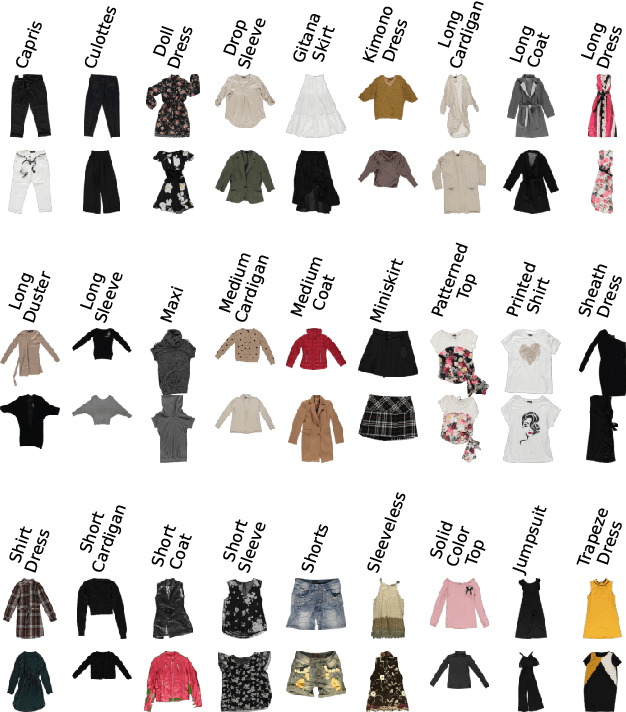
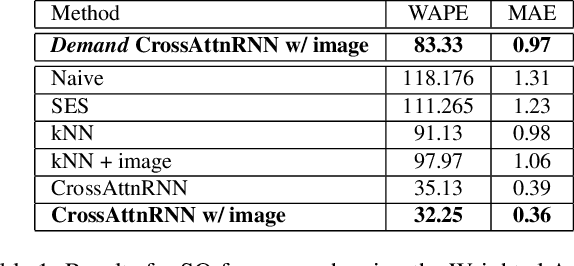
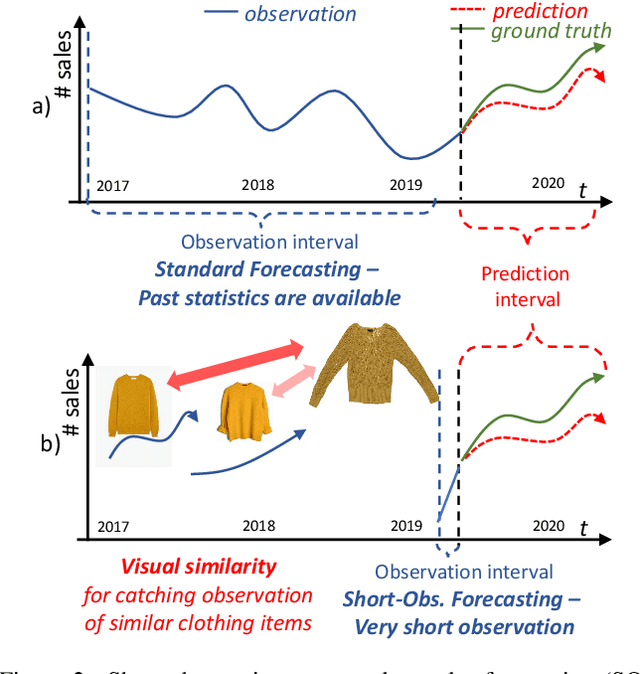
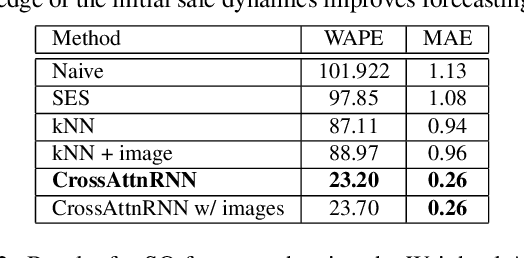
Abstract:We present Visuelle 2.0, the first dataset useful for facing diverse prediction problems that a fast-fashion company has to manage routinely. Furthermore, we demonstrate how the use of computer vision is substantial in this scenario. Visuelle 2.0 contains data for 6 seasons / 5355 clothing products of Nuna Lie, a famous Italian company with hundreds of shops located in different areas within the country. In particular, we focus on a specific prediction problem, namely short-observation new product sale forecasting (SO-fore). SO-fore assumes that the season has started and a set of new products is on the shelves of the different stores. The goal is to forecast the sales for a particular horizon, given a short, available past (few weeks), since no earlier statistics are available. To be successful, SO-fore approaches should capture this short past and exploit other modalities or exogenous data. To these aims, Visuelle 2.0 is equipped with disaggregated data at the item-shop level and multi-modal information for each clothing item, allowing computer vision approaches to come into play. The main message that we deliver is that the use of image data with deep networks boosts performances obtained when using the time series in long-term forecasting scenarios, ameliorating the WAPE by 8.2% and the MAE by 7.7%. The dataset is available at: https://humaticslab.github.io/forecasting/visuelle.
Spatial Commonsense Graph for Object Localisation in Partial Scenes
Mar 14, 2022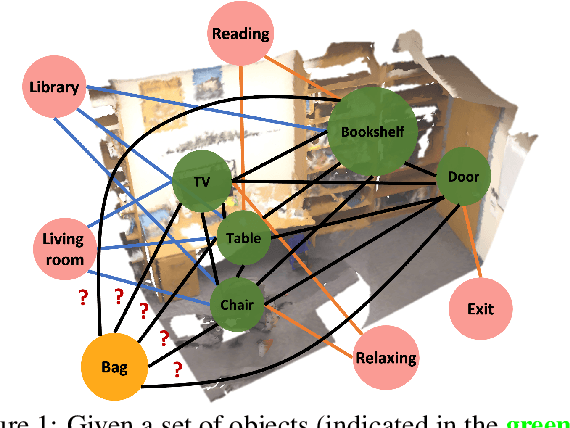
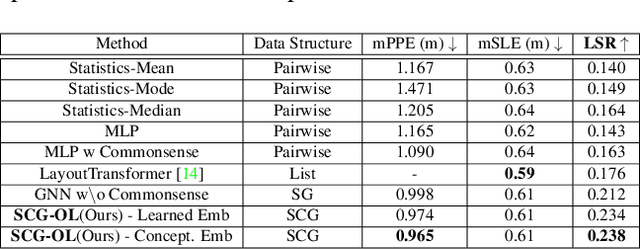


Abstract:We solve object localisation in partial scenes, a new problem of estimating the unknown position of an object (e.g. where is the bag?) given a partial 3D scan of a scene. The proposed solution is based on a novel scene graph model, the Spatial Commonsense Graph (SCG), where objects are the nodes and edges define pairwise distances between them, enriched by concept nodes and relationships from a commonsense knowledge base. This allows SCG to better generalise its spatial inference over unknown 3D scenes. The SCG is used to estimate the unknown position of the target object in two steps: first, we feed the SCG into a novel Proximity Prediction Network, a graph neural network that uses attention to perform distance prediction between the node representing the target object and the nodes representing the observed objects in the SCG; second, we propose a Localisation Module based on circular intersection to estimate the object position using all the predicted pairwise distances in order to be independent of any reference system. We create a new dataset of partially reconstructed scenes to benchmark our method and baselines for object localisation in partial scenes, where our proposed method achieves the best localisation performance.
 Add to Chrome
Add to Chrome Add to Firefox
Add to Firefox Add to Edge
Add to Edge